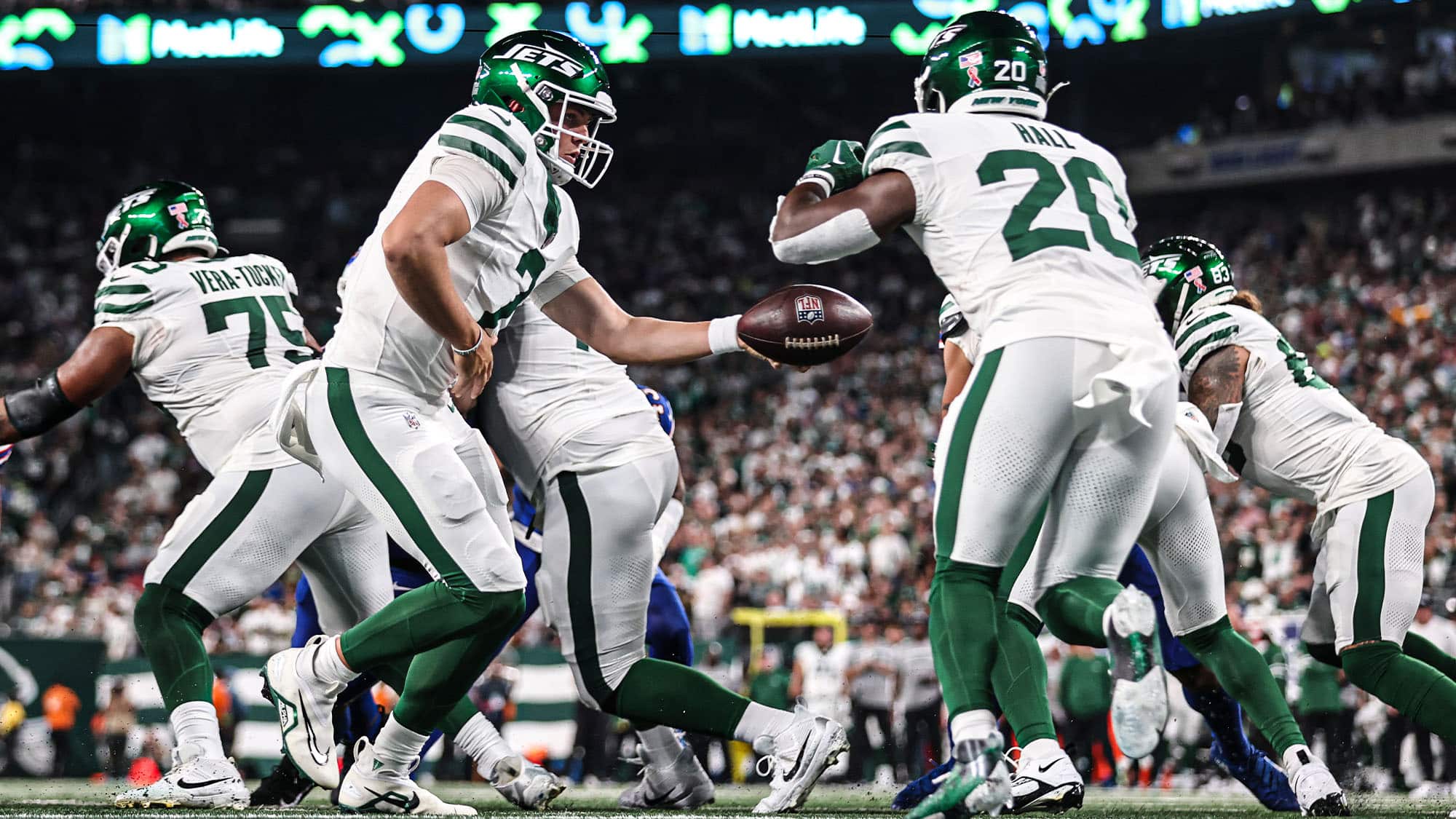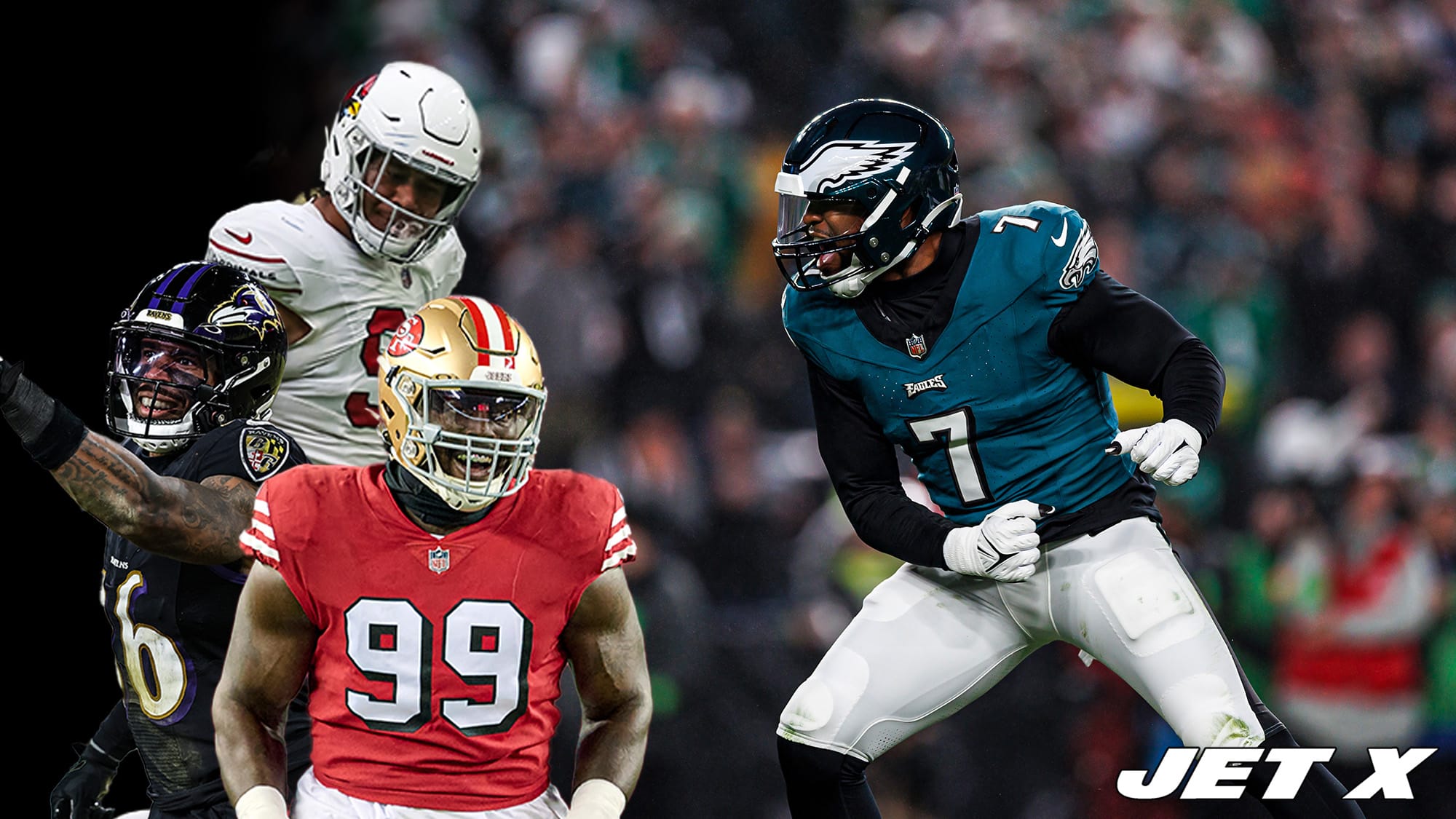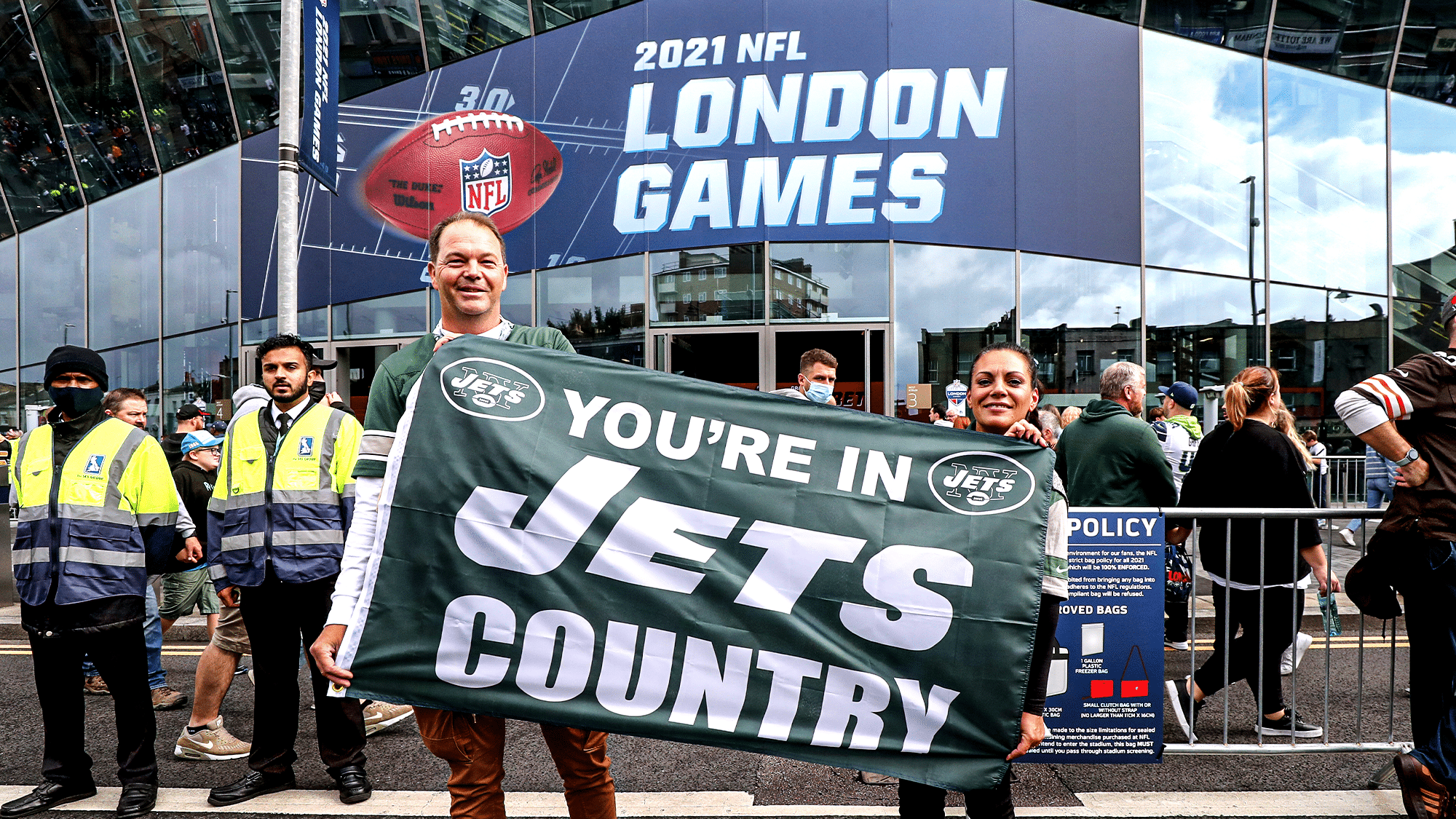The New York Jets cannot succeed with a one-dimensional offense
With Zach Wilson under center and Breece Hall running the ball at a historically great level, many people have offered up a simple solution for the New York Jets offense going forward: just run the damn ball.
It sounds great in theory. In a modern NFL where defenses are getting lighter and lighter in order to match the speed of pass-heavy offenses, perhaps the Jets can counter by pounding the rock down their throats. Feed Breece, let AVT and Mekhi pave the road, and prosper.
There’s just one problem: Running the ball is difficult when defenses don’t respect your passing game.
The run game cannot be the only threat your offense poses. If that’s the case, defenses are just going to stack the box and dare your quarterback to beat them. Then, if your quarterback cannot punish the defense for stacking the box, your offense will be completely out of answers. The run game will be silenced by stacked boxes and the passing game will struggle regardless.
In order to be a successful run-heavy offense in the modern NFL, you need to have an efficient passing game that forces defenses to lighten the box.
Some of the most famous run-heavy offenses in recent years include those of the Baltimore Ravens, San Francisco 49ers, Philadelphia Eagles, and Tennessee Titans. While all of these teams ran the ball at high rates, they all had efficient passing attacks to complement the run game. This is why they were able to rely on the run as their primary weapon. Teams couldn’t sell out to stop the run because they feared paying the price through the air.
The 2022 Eagles were best known for their run game, led by quarterback Jalen Hurts and a dominant offensive line. They ranked third in rushing attempts (544) and 23rd in passing attempts (536). However, while they didn’t pass the ball often, they were efficient when they did, ranking second in the league with 8.1 yards per pass attempt and sixth with a 99.3 passer rating.
The 2021 Niners made a surprising run to the NFC Championship Game on the strength of a versatile wide-zone rushing attack that put the ball in the hands of various players, namely wide receiver Deebo Samuel. San Francisco ranked fifth in rushing attempts (499) and 29th in passing attempts (514). Still, they were second with 8.6 yards per pass attempt and ninth with a 99.2 passer rating.
The 2020 Titans had an elite offense on the back of Derrick Henry. They were second in rushing attempts (521) and 30th in passing attempts (485). Once again, passing efficiency was vital: the Titans ranked seventh with 7.9 yards per pass attempt and fifth with a 105.9 passer rating.
The 2019 Baltimore Ravens raced out to 14 victories thanks to Lamar Jackson’s MVP season and a power run game that shredded the will of opponents. Baltimore led the league in rushing attempts (596) and was last in passing attempts (440). Still, the Ravens tied for 10th in yards per pass attempt (7.6) and second in passer rating (109.0).
Some might argue that these teams’ effective run games are what set up the success of the passing game rather than vice versa. But in a pass-heavy league where teams are far more afraid of aerial threats than ground threats, it’s more likely that passing efficiency dictates rushing efficiency instead of the other way around.
Don’t get the wrong idea from the examples I used, though. I’m not saying that Wilson and the Jets’ passing attack need to have elite efficiency at the level of those aforementioned teams if they want to run the ball effectively. That’s certainly not a requirement. But it is a requirement for the passing game to at least be competent. Look no further than the 2022 Atlanta Falcons.
With Marcus Mariota and Desmond Ridder under center, it’s safe to say the 2022 Falcons passing game was nowhere near elite. However, it was surprisingly respectable.
While Atlanta passed the ball at a very low volume (they were 31st in pass attempts at 415 and first in rushing attempts at 559), their passing game had league-average efficiency. Atlanta tied for 11th in yards per pass attempt (7.1) while ranking 15th in pass offense DVOA and 17th in passer rating (87.7).
Respectability in the passing game was all Atlanta needed to set up an elite rushing attack. With a fantastic run-blocking offensive line and an elusive running back unit, the Falcons ranked third in rush offense DVOA and fourth in yards per rush attempt (4.9).
On the strength of a high-volume/high-efficiency run game that was backed by a low-volume/average-efficiency pass game, the Falcons quietly fielded one of the league’s better offenses. They finished eighth-best in overall offensive DVOA.
This is the model the Jets should aim to replicate in 2023.
Well, perhaps they shouldn’t quite go to the severe degree of run-favoring that Atlanta utilized, but you get the idea. New York just needs league-average efficiency from its passing game to allow for an elite run game that can carry the offense and lighten the load on Zach Wilson’s shoulders.
Simply put, the Jets will not run the ball well if Wilson and the passing attack perform as poorly as they did in 2021 and 2022. It just won’t happen. No matter how historically great Breece Hall is, or how overwhelming Alijah Vera-Tucker and Mekhi Becton are for opposing defenders, you won’t succeed by relying on the run game if there are consistently more defenders than blockers in the box.
The Jets learned this the hard way with Wilson under center near the end of 2022.
New York’s Week 15 loss to the Lions exemplified this perfectly. With no fear of Wilson, Detroit stacked the box all day long. According to NFL Next Gen Stats, there was an average of 7.18 defenders in the box per Jets rush attempt, ranking fifth-highest in the NFL that week. For perspective, that number would rank second-highest in the 2022 season as a whole. It’s an extremely high mark.
The strategy worked like a charm for Detroit as New York averaged just 2.3 yards per carry. They only ran for three first downs on 22 rushing attempts, and one of them was a QB sneak. The Jets’ longest run of the day went for six yards.
But with Detroit loading the box so aggressively, the Jets should have been able to punish the Lions for leaving extra space on the back end – especially considering Detroit had a terrible secondary. The Lions finished 2022 allowing the second-most yards per pass attempt in the NFL (7.9).
Wilson couldn’t take advantage.
The circumstances were perfect for the Jets’ passing game to absolutely explode. One of the league’s worst pass defenses was making itself even more vulnerable by consistently removing a defender from coverage and placing him in the box. Plus, the Jets were at home.
Despite the highly favorable environment, Wilson produced only average results, which made it a poor performance considering the margin between his raw output and the expectations. He didn’t do nearly enough to maximize the friendly circumstances or back off the Detroit defense.
Wilson had an 89.8 passer rating and averaged a dead-even 0.00 EPA per dropback – he was lucky the numbers weren’t much worse, as Michael Carter miraculously saved a should-be interception. The Jets scored a measly 17 points (the second-fewest allowed by Detroit on the road in 2022) and ended up losing the game. This output was well below what Wilson and the Jets should have been capable of considering the quality of the opponent and the approach they used.
With Detroit going all-out to stop the run – and achieving extremely successful results – the Jets’ passing attack needed to be great to force Detroit to stop being so aggressive against the run. It wasn’t. So, the Lions just kept selling out to stop the run, because their only punishment was a “meh” passing game. That was a trade-off they were happily willing to take.
In 2023, New York’s opponents will be willing to take the same trade-off – especially because most teams will have a far better secondary than that Lions team did, leading to passing-game results that are much worse than merely “meh”.
In fairness, the Jets did not have Hall, Vera-Tucker, or Becton in that game. They only had Hall and Vera-Tucker for the first six-and-a-half games, and they never had the entire trio together.
With these players, the floor of the Jets’ run game will surely be much higher than it was in the second half of 2022. Hall is too talented to not break loose for a big gain every now and then, regardless of how many defenders he has to run through. Vera-Tucker and Becton are too good to not carve out some holes for the Jets to at least get some positive chunks. It’s hard to imagine the Jets’ run game will ever be much worse than average, even if the passing game does nothing to help it.
With that being said, if the Jets’ run game is going to fulfill its elite ceiling – because it truly does have the potential to be the league’s best – the passing attack has to demand at least some respect.
The biggest key to demanding that respect? Succeeding on play action. That is the best way to lessen the defense’s aggressiveness toward the run game. Throwing the ball well out of traditional dropbacks will help, too, but it will have a much greater effect if you can make defenses think twice about biting down on a potential handoff.
Once again, the 2022 Falcons provide a model for success here. Marcus Mariota was quite solid on play action passes last year. Out of 35 qualified quarterbacks, Mariota ranked ninth in yards per attempt (8.8) and 15th in passer rating (102.6) when using play action. Atlanta utilized an extremely high rate of play action, too – Mariota used play action on a league-leading 44.4% of his dropbacks.
Mariota was exposed on non-play action dropbacks, ranking 25th in yards per attempt (6.3) and 30th in passer rating (76.9). But his success with play action was enough to open space for the run game. The Falcons played into Mariota’s strengths and weaknesses by using a very high rate of play action, which in turn made it the perfect weapon to consistently free up their run game.
This should be the formula for New York. Even if Wilson continues to struggle on traditional dropbacks, play action success can be Wilson’s bread-and-butter. If dialed up correctly, play action can maximize Wilson’s physical traits and simplify his reads, allowing his strengths to shine and his weaknesses to be hidden.
It’s up to Nathaniel Hackett to scheme up favorable play action opportunities for Wilson. If Hackett can do that, and Wilson can do his part by executing, the Jets might be able to demand enough respect from defenses to keep the box clean, setting the table for an elite rushing attack.











